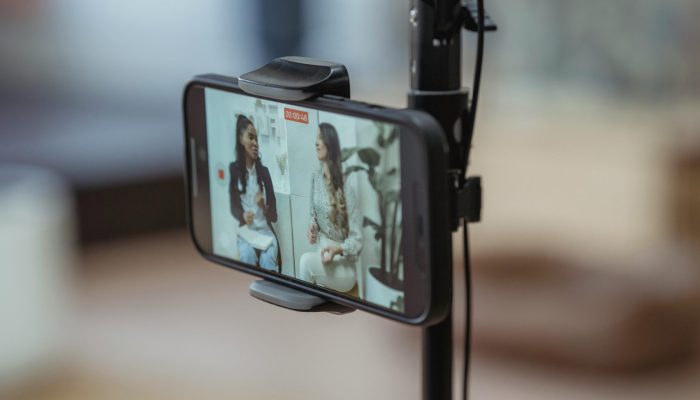The “omni” part of the term as we know = all. So, let’s work through the “channel”.
Which should you use in your organisation?
The good news is that “all” is subjective to your individual business. You’re not expected to really do everything to hope to succeed in omnichannel. You’d have to be a particular e-retail tycoon to be able to afford channels of marketing in all your target regions intrinsically interlinked at once, and we think even he’d struggle.
The first rule of thumb in omnichannel marketing is that all you do is customer-centric. Everything is about your specific customers’ journey, their needs, and meeting them where they’re at. If that’s the case, it makes sense that we put the customers first when strategically positioning the business.
There is too much pressure on businesses to adopt all forms of marketing. Take Pinterest and InstaShop, for example. Most marketing advice encourages you to embrace new platforms as they emerge and to stay relevant. But social media isn’t that black and white. It’s highly likely these channels, in particular, could be of interest to your audience. But if your data shows these channels to be low interest to your customers, and actually they prefer apps, in-person, and LinkedIn, absolutely have the confidence to pour your resources into those channels instead. You need to choose platforms that align with your brand’s overall identity and meet your customers where they actually visit. Otherwise, you’re wasting time and money for no one’s real benefit other than those of the channels themselves.
Take the time to look at your buyer personas and audience types. Consult your customer data. Look at your existing campaigns. Where are your audience? Then, you can choose which of the channels to commit to. The list of channels itself is ever-growing but typically can be categorised into:
- In-store retail
- Online retail and e-commerce
- Mobile applications
- Marketplaces
- Online digital media (including social and email marketing) Social Media
- Offline media?
- Partnerships
Let’s work through each channel and consider their current landscape:
In-store retail
While it’s been turbulent over the last three years, retail isn’t quitting. There are benefits for consumers that online will never replace. For example, we’re tactile creatures. We like to feel, see, taste or smell if needs be. The ability to shop in-store gives us a sensory buy-in for our purchases. Ordering 3 sample tiles in a home kit at a time when you’re renovating your kitchen isn’t the same as being able to walk into a store and touch and compare hundreds of designs at the same time. Just like reading a floral oud, sweet base notes with vanilla might sound like a good present for your partner, but until you are able to spray in-store, you never really know whether or not you think they’re going to like it.
Shopping extends beyond a mere transaction; it’s a sociable event. The need for assistance and the joy of shared experiences drive consumers to physical stores. Nothing beats the personalised guidance and social interaction that come with in-store shopping. Click and Collect stands as a hybrid solution, giving the convenience of online shopping with the speed and face-to-face contact of an in-store shopping experience.
The pandemic created ingenious ideas to overcome these hurdles, but when our doors opened, consumers came back to retail. Otherwise, we’d all be at home 100% of the time.
Online retail and e-commerce
E-commerce, a longstanding presence, underwent a transformative surge in 2020, triggered by the challenges faced by brick-and-mortar stores during the pandemic. Rather than viewing this as a setback, it’s essential to recognise the evolving landscape and proactively adjust to stay at the forefront of industry trends.
The lives of consumers have undergone significant shifts, and aligning with these changes is key to thriving in the current market.
According to Time Magazine, working from home (WFH) accounted for only 5% of all workdays before the pandemic, but as of December 2022, almost 30% of paid workdays are WFH. 70% of workers with a higher disposable income earning £30,000 or more hybrid worked throughout the COVID-19 and post-pandemic period – a substantial shift compared to 2020. Reportedly, lower-income earners are less likely to work from home. This is shown by only 8% of those earning up to £15,000 reported hybrid working according to Working from Home UK statistics 2023.
It’s crucial to recognise that these changes have not only altered work dynamics but also reshaped consumer behaviour. The convenience of working from home has translated into a significant shift in shopping patterns. With the absence of the traditional office lunch break and impromptu retail outings, consumers are increasingly turning to online platforms for their shopping needs.
This trend is projected to intensify, with an estimated 49.7% of total non-food retail sales expected to be conducted through e-commerce by 2025.
The evolving landscape offers you a wealth of opportunities to adapt to the changing needs and preferences of consumers. Rather than dwelling on the challenges posed by the shift to e-commerce, embracing this evolution opens the door to a new era of innovation and customer engagement.
Mobile applications
Mobile phones are this odd phenomenon that has been, for most of us, become a fifth limb. We’re never without them. Try to remove it from a teenager, and their protests are testimony of this. There are a few things you can’t do from your phone. Find love, stargaze, and turn off your central heating. From a more practical retail sense, you can favourite, save, and re-order your favourite items, access loyalty cards and rewards, engage with interactive elements, such as QR codes, use click and collect, and a whole host of digital solutions. According to Statistica and their Most used smartphone apps by type in the UK report, 49% of users use retail apps. And for good reason. Customers are comfortable saving their details and creating profiles because of the personalisation and ease that come with them.
Marketplaces and distributors
It takes considerable investment to make a retail outlet a success. That’s the case for both bricks-and-mortar stores and online. People are more likely to visit Currys than Jerry’s Laptop Shop as it’s a brand they’re familiar with and trust. So, while you might have a digital store and multilocations of your own, why not explore which on- and off-line stores your customers frequent and leverage their footfall, too? Platforms like Amazon, eBay, Etsy, and even social media shopping outlets provide a gateway to new and extensive customer bases. Leveraging these marketplaces allows you to tap into their established audiences, enhancing your brand’s visibility and credibility. As new customers get familiar with your brand, you can, over time, transition them to purchasing direction through you, perhaps through your app or online. Bricks-and-mortar distributors allow you to tap into new footfall to test new regions and products without heavy investment. Omnichannel marketing comes from integrating with your warehouse, production, and ordering systems to ensure stock numbers from external marketplace and distributor sales are considered.
Online personalised digital media (including social and email marketing)
Gone are the days when generic marketing campaigns are enough. Today’s customers crave personalisation and coding [FNAME] into a generic email marketing campaign, which isn’t enough. Personalisation means creating a holistic experience that makes them feel understood and valued. They want an experience tailored to their preferences, behaviours, and needs.
The combinations of channels to use depends on your goals, target audience, and budget. When you leverage your customer data to segment your audience effectively, you can lean into the channels that meet them most where they’re at.
- Search engine optimisation (SEO)
- Search engine marketing (SEM)
- Content marketing
- Social media
- Email campaigns
- Affiliate marketing
- Influencer marketing
- Automation
- Video
- Mobile
- Display advertising
- Remarketing/retargeting
- Native advertising
- Chatbot marketing
- Podcast marketing
- Webinars and live streaming
- Geo-targeting
- Growth hacking
By understanding demographics, purchase history, and browsing behaviour, you can send targeted messages across channels that resonate on a more personal level.
Offline media
Despite the world becoming increasingly online, digital marketing isn’t the be-all and end-all when it comes to your omnichannel marketing presence. Traditional offline media still holds its own and complements your online efforts to reach your audience. The world has become a living, breathing ecosystem of advertising. At any given moment in built-up areas, your eye line is subconsciously being drawn to a brand image.
- TV
- Radio
- Direct mail
- Trade shows and events
- OOH
- Telemarketing
- Newspaper inserts
- Cinema advertising
- Branded merchandise
- Vehicle wraps
- Guerrilla marketing
- Direct sales
- Public relations
- Product placements
- Brochures and catalogues
- Bumper stickers
Offline media is great for building brand awareness and trust and works hand-in-hand with your online channels to create a cohesive brand presence.
Partnerships
What do GoPro and Red Bull; Gucci and North Face; and Ryan Reynolds and Wrexham Football Club all have in common? They all successfully demonstrate that two can be better than one, and you don’t have to have partners in the same space to make a success. Partners, influencers, or complementary create new opportunities and broader markets to tap into without the need to establish an entirely new platform or product. If partnerships are something you’re considering, take note of their reputation and make sure you do due diligence. You want to partner with a brand whose values and principles align with your own as a business. Then, it’s important to consider that both you and your partner’s systems interlink where they need to do so. Otherwise, your partnership data ends up in silo.
Navigating the diverse array of opportunities—from in-store and online retail to mobile applications, marketplaces, digital media, and more—highlights the importance of a customer-centric approach to your strategy. Omnichannel marketing isn’t about being everywhere; it’s about being where it matters most to your customers.
No matter where you are on your omnichannel journey, there are always ways to finetune your existing process to improve your results. That’s where we come in. If you’d like help with your omnichannel marketing strategy, then get in touch at [email protected]. We’d be delighted to explore your options with you.







